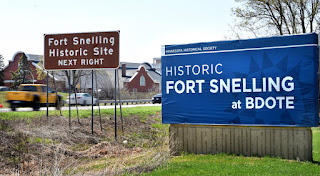 Last week the Minnesota Senate cut funding for the Minnesota History in apparent retaliation
Last week the Minnesota Senate cut funding for the Minnesota History in apparent retaliation for the latter changing the name of the Fort Snelling to “historic Fort Snelling at Bdote.”
“Bdote” is the original name given to the area by the Native-Americans who originally inhabited the area. Justifying this action, Senate Mary Kiffmeyer declared changing the name is “revisionist history” and that “Fort Snelling is about military history, and we should be very careful to make sure that we keep that. It’s the only real military history in a very unifying way amongst all Minnesotans. It is our premiere entity for military history.”
I leave to others the judgement regarding whether this action is racist or offensive. Instead, is this revisionist history?
The days are long gone when historians such as Leopold von Ranke who reputedly argued that the task of history and historical knowledge is to “tell it like it is.” Such as theory assumes that there are objective historical facts that are timeless ans which can be verified. For the most part that theory has been refuted and regulated, so to speak, to the dustbin of history. As later historians such as E.H Carr and Fernand Braudel point out, there is no such things as objective historical facts. The art of history is interpretive– it is historians selecting facts in order to construct a historical narrative.
Even more, the act of deciding what is a fact is normative, not objective. History, as the philosophers Soren Kierkegaard and Hans-Georg Gadamer point out, is always understood from the present; it is how we understand the past as viewed through our experiences. History and historical meaning, as I argued with Leon Goldstein in Conceptual Tension, is perhaps always being revised in light of new undertandings, meanings, or senses of what is important. “Facts” thought to have once been important, lose their significance over time or are seen in new light as a new generation come to view the world differently than those in the past. The best indication of that, is the often (mis)-quoted statement by Zhou Enlai who when asked by Henry Kissinger about the impact of the French Revolution said it was “too soon to tell.” Similarly, George Santayana’s “Those who fail to learn the lessons of history are doomed to repeat it” and G.W.F. Hegel’s “the only lesson of history is that we fail to learn the lessons of history” similarly speak to the notion that there are no objective historical facts that are immutable. History is how we in the present understand the past.
Kiffmeyer’s concept of history about Fort Snelling suggesting its name is a unifier for Minnesota’s is reminiscent of the quip that history is written by the winners. To say the name Fort Snelling unites Minnesotans lives out many. It leaves out of course Native-Americans who first inhabited the place for thousands of years before the US military. Calling it Fort Snelling is revisionist from the name originally given it by the original inhabitants.
Fort Snelling excludes African-Americans. After all, the is the place a slave holder took his slave Dred Scott to from the south, resulting in one of the most infamous Supreme Court cases in history Dred Scott v. Sanford which declared black people were property and could not be citizens. This case precipitated the Civil War.
Finally, it is hard to seen how “Fort Snelling” embraces the Hmong, Latinos, and so many other groups in Minnesota. What is it they share with that name?
“Fort Snelling is not an immutable name that is inclusive of all. It is already revisionist history and labeling, much in the same way that so many of the names in Minnesota are revisions of original names whose names and significance have changed over time. Words matter and as language philosopher Ludwig Wittgenstein pointed out, words get their meaning f rom context and use. As both change do what words mean.
At one time perhaps “Fort Snelling” conveyed a unifying meaning but no longer does. “historic Fort Snelling at Bdote” might better capture what the place historically means represents to a more inclusive audience, when viewed from the present. Fort Snelling, to be truly a treasure for all Minnesotans, cannot be something whose name and significance is frozen in the past, held hostage as property by a few at the exclusion of others. To think that is really revisionist history.
PS: Photo courtesy of the Pioneer Press.


